Research Question and Theoretical Framework
Student publications at institutions of higher learning are instruments of memory-formation. Particularly for yearbooks and annuals, publications designed to be viewed and prompt memories, the selection of images is inherently a process of curating the reality of a time period into how one would like it to be remembered. By choosing to include certain images and exclude others, the creators of yearbooks and annuals curate what memories are recollected when viewing the publication. This is particularly impactful for the time before the digital age, before increasing amounts of everyday life can be captured in photo or video. The central research question that guided our project was thus an investigation of how the processes of memory-formation in student publications at our predominately white institutions (PWI) reflect attitudes towards people of color (POC) and the civil rights movement of the 1960s. Did the images selected for memory-recollection during the 1960s reflect broader changes in attitudes towards race occurring in the country at the time or was there a reinforcement of the systemic racism undergirding higher learning as a PWI?
The theoretical underpinnings of this project stemmed primarily from historical methodology, notably Foucault’s concepts of discourses and memory formation. Concurrently, we attempted to incorporate ideas about data activism from D’Ignazio and Klein’s Data Feminism. There seemed to be a connection between their assertion that sometimes how data is collected can reflect structural issues in a project and how the project of memory-formation in yearbooks was dictated by those curating the included images. In this relationship, the images of a yearbook were the “data” that was collected and assembled to produce the final product of the yearbook. Just as ignorance, prejudice, and inherent biases can undermine the validity of data projects, the same problems affected the curation of these images and resulted in skewed perspectives of the reality at the time of their collection. It was thus the goal of this project to take a look at what “data” was selected in the images and tell a story about how it might have skewed memories about POC and civil rights at the PWI during the 1960s.
Conclusions
The information from our project has ultimately led us to conclude that there was a distinct element of exclusion within the PWI memory-formation publications of the 1960s. In most years there was little, if any, acknowledgement of the broader societal changes regarding race in the publications we studied. From 1960 to 1962 there was no image of any person of color (POC) or reflection of attitudes towards race at all.
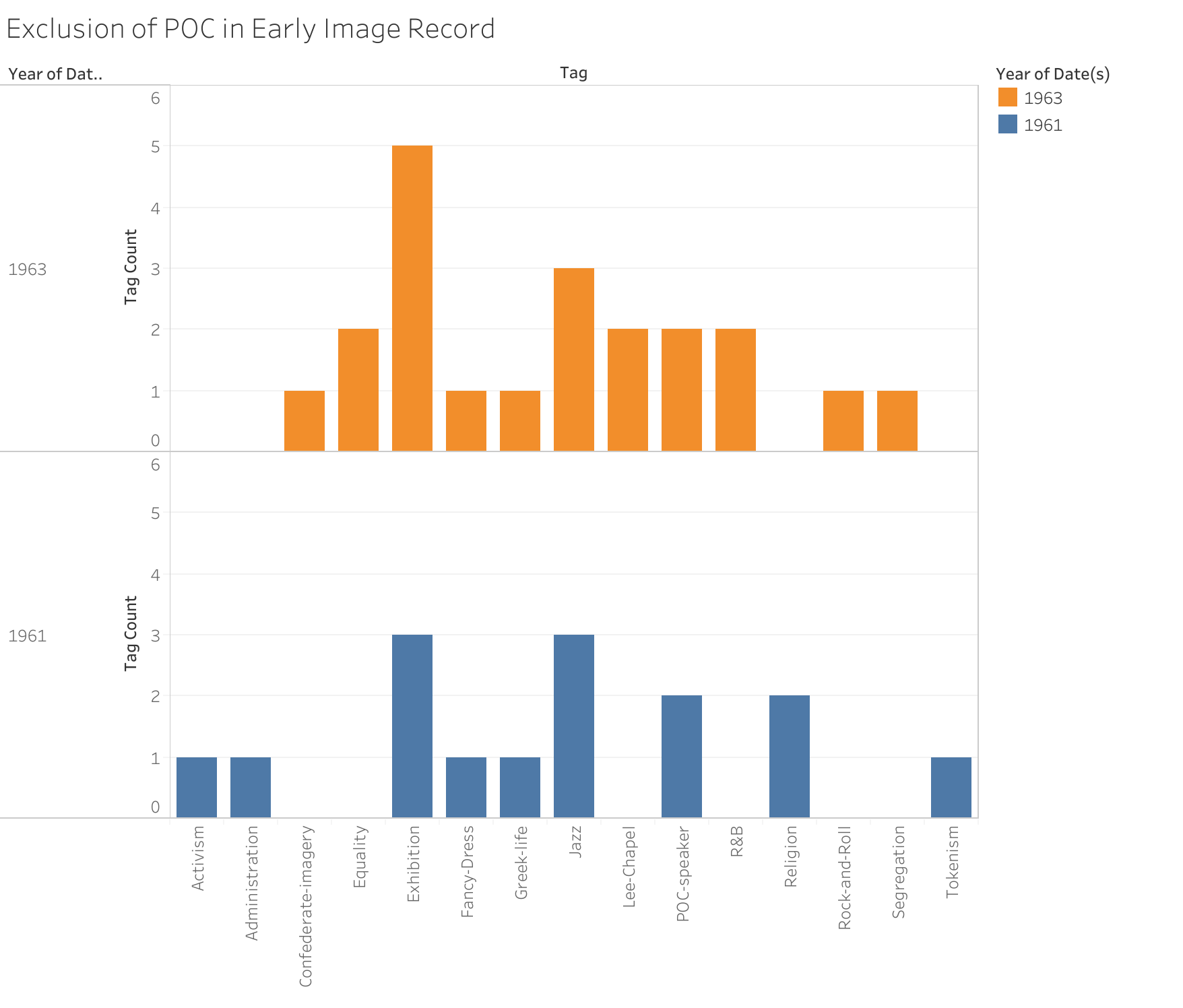
This visualization shows all of the image tags from the earliest years of the decade. Across the 45 source images from the first 4 years of the decade, there was little representation of POC or civil rights within the image record of the student publications. In the years 1960 and 1962 there were no images even tenuously related to our group’s inquiry. The tags from the years 1961 and 1963 meanwhile demonstrate that there was very limited visibility of POC and the civil rights movement on the campuses of the PWI at this time. The notable inclusion of POC speakers within the record comes from the controversy of Dr. Martin Luther King, Jr. being prevented from speaking on Washington & Lee’s campus in 1961 and acknowledgement of the author Ralph Ellison being the first Black speaker on Washington & Lee’s campus to fill up Lee Chapel, the largest speaking venue on campus and also the burial place of Robert E. Lee.
Following 1963 there was a change in the trends of the tag data and images of POC began to appear quite frequently. However, from 1963 to 1967, these appearances were almost exclusively in the role of performers or service industry workers. This perhaps reflects a perceived racial stratification within society at the PWI.
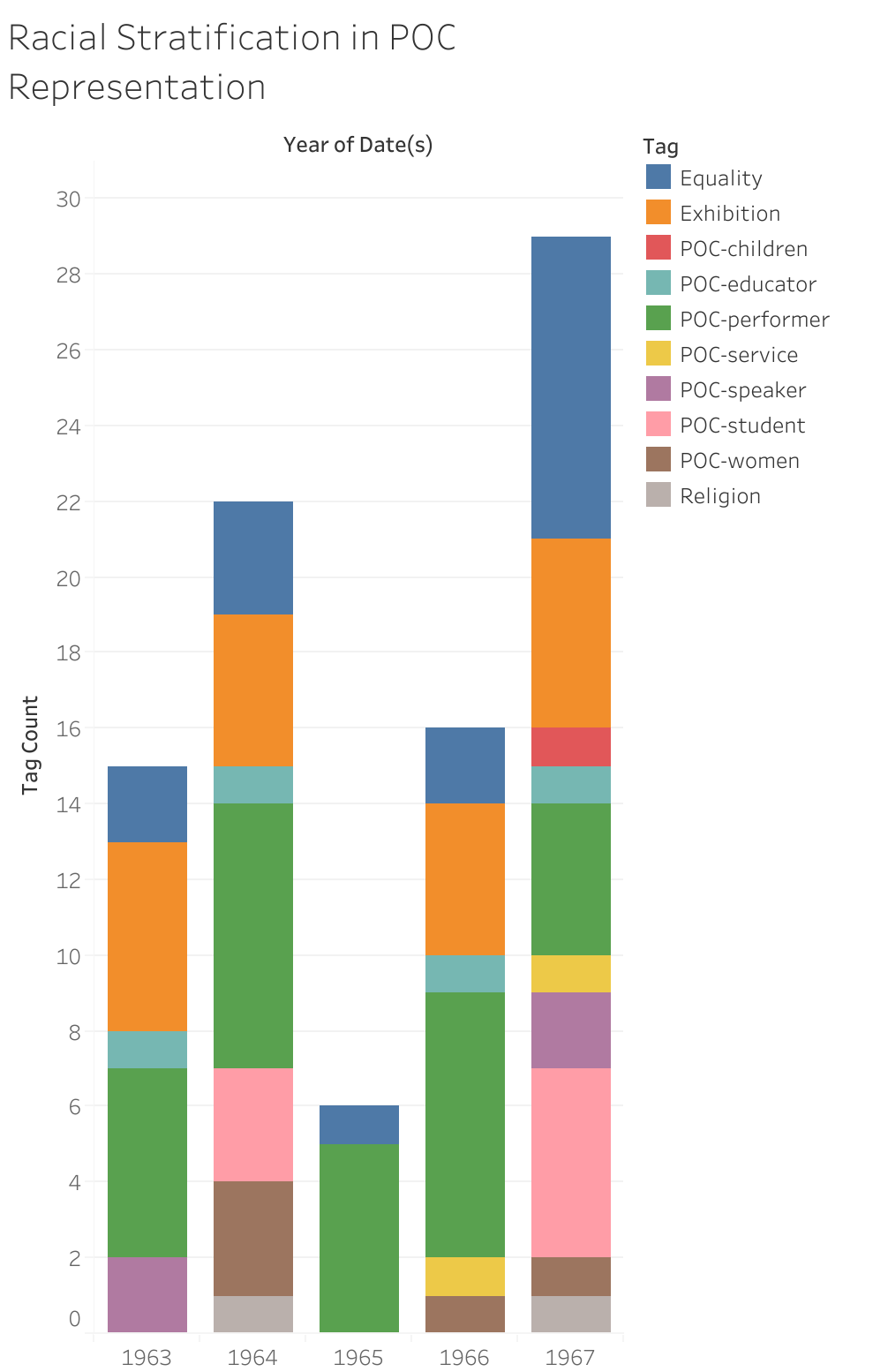
For more than half the decade POC and civil rights either did not greatly impact student life at the PWI or were deliberately marginalized in the memory-formation of that time. This changed in 1967 when POC and civil rights began to appear much more consistently in the image record and with a much greater variety.
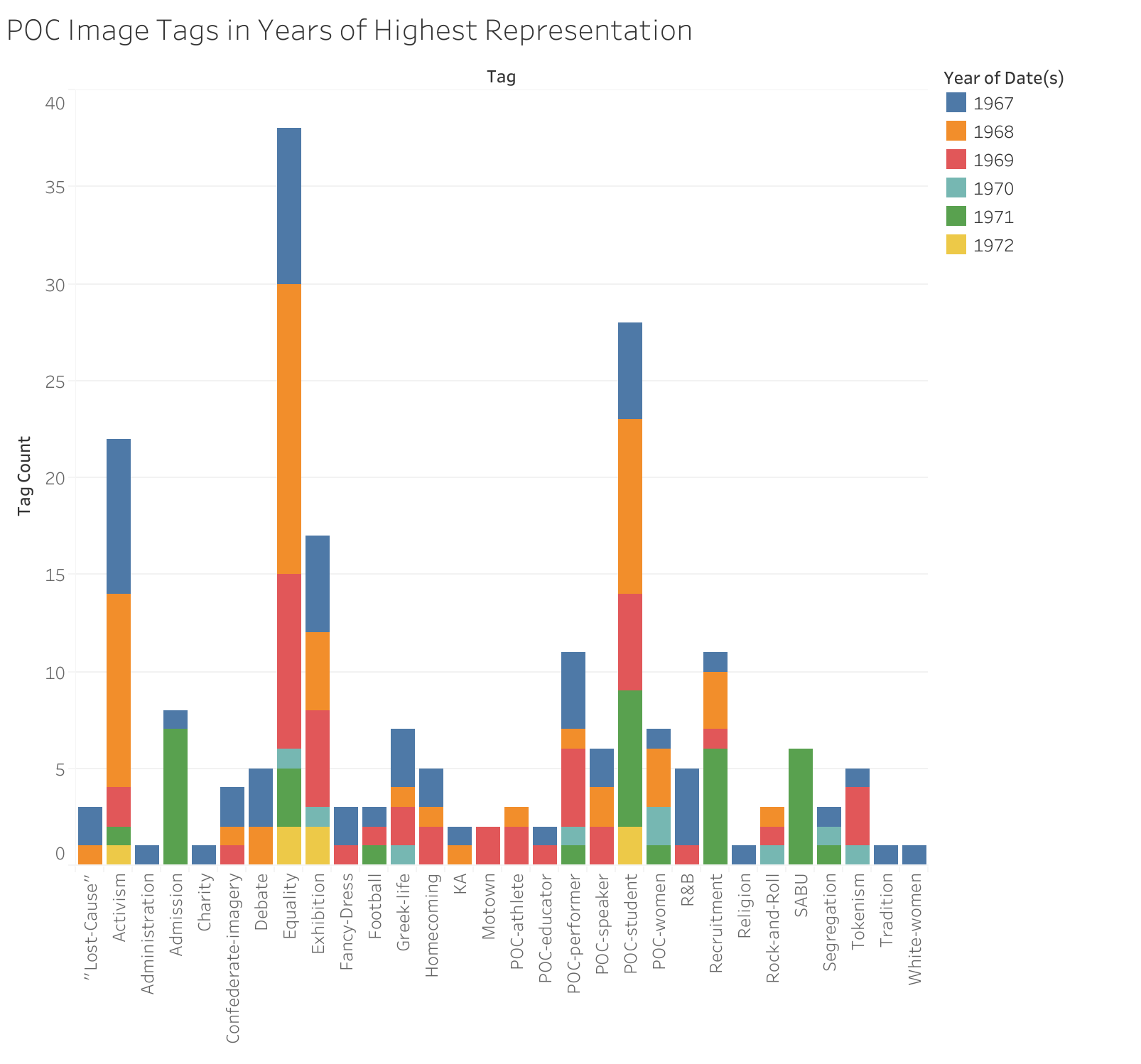
Instead of being limited to performance and service spheres of memory, POC began to appear in the record as students, educators, speakers, and activists. This would imply that while most of the policy achievements of the civil rights movement of the 1960s took place in the first half of the decade, it took till almost the end of the decade for the political and social changes of the movement to impact the memories of students at PWI.
While this change is significant, southern institutions such as Washington & Lee displayed consistent, underlying elements of Confederate, “Lost Cause,” and segregation imagery. From 1960 to 1970 there were consistently images that reminded W&L students of a racialized, “Southern” identity, an identity that remained largely unchanged by the progress of the decade.

Research Methods
Our group extracted visual data from the images that appeared in the student publications The Algol, The Calyx, The Carletonian, and The Ring-tum Phi. Machine-readable data was extracted from these yearbooks and newspapers through a system of image tags. After first compiling a source sheet of 108 different images related to the issues of POC representation and civil rights from the student publications, we then began to give each image a list of “tags” that either described the people/events in the image or related the image to a potentially broader phenomenon within the historical narrative of the civil rights movement. These tags were created and assigned as we went through and viewed each image in turn; we did not begin with a set list of tags that could have been potentially less descriptive and more limiting of the information from the images. Across the 108 different source images we attributed 369 tags that when viewed independently could serve as machine-readable data points. These tags either described the people, events, or locations in the image or related the image to a potentially broader phenomenon within the historical narrative of the civil rights movement. Below is an explanation of each tag and their reason for inclusion in the data set.
After cleaning and standardizing the tag data through OpenRefine, the .csv data was linked to Tableau Public, a data visualization program that allowed us to create the above images to explain our findings.
Tag Breakdown
Descriptive Tags
- Administration – This tag is attached to those images which depict any interaction between POC or civil rights with the source institution’s administration, from deans and department heads to Board of Trustees’ members. These individuals or groups could represent the official positions or attitudes taken by the source institutions on subjects of POC and civil rights.
- Charity – Images depicting student charity or volunteer action were tagged to study the placement of POC and civil rights within community activism.
- Confederate-imagery – Any instance of a Confederate flag, Confederate statue, or similar allusion to the Confederacy was tagged to study whether these images held the same controversial status in society as they do today.
- Conservative-speaker – This tag refers to a single image of then-presidential candidate Richard Nixon speaking on campus. This image was tagged to compare with images depicting POC-speakers, particularly because images of white speakers were rare within the image record.
- Fancy-Dress – The largest social event of the year on Washington & Lee’s campus, this tag was created because this event has been more heavily funded and controlled by the administration than other, smaller events.
- Football – A staple of American College culture since the early 20th century, images of the large gatherings at football games or those relating to football were tagged to study how the fundamental sporting identity of the schools relate to the themes of the project.
- Greek-life – Although not every source institution allowed Greek organizations on their campuses, where present Greek life was central to campus social life. Tags of this white, patriarchal system’s interactions with the themes of the project were thus more unofficial, but potentially more representative, than images expressly endorsed by the institutions.
- Homecoming – The most common large student social event, images of Homecoming functions were tagged to study the presence of the project’s themes at these large social gatherings.
- KA – The Kappa Alpha order is a fraternity that repeatedly appeared in the image record connected to both Confederate imagery and POC representation. The fraternity is notable for claiming Robert E. Lee as their founder and this tag was created to track the relationship of this organization, as a contributor to institutional racism, with the themes of the project.
- Law-school – Today some Law-schools are more activist and anti-racist than their undergraduate counterparts. This tag was created to study if elements of the institutions more overtly concerned with legal structures interacted with the themes of the project differently than the undergraduate sphere of the institution.
- Lee-chapel – The burial place of Robert E. Lee, Lee chapel is fundamentally tied to Lost Cause mythology and images where it was connected to the themes of the project were tagged to study how much Lost Cause and Confederate imagery is spatially tied to this one location.
- Lexington – Images of the project’s themes connected to the town of Lexington, VA were tagged to study how the local PWI, Washington & Lee University, was disconnected from the broader multiracial community that occupies the same geographic space.
- Lynching-imagery – Given that one of the impetuses of this project was the “Georgia Club Photo” from Davidson College that so prominently featured lynching-imagery, this tag was created to see if similar problematic imagery existed among any of the contributing institutions. Only a single image was found to contain something akin to this tag, an image of a student production of the play Waiting for Godot. Although it is unclear what exactly is occurring in the play at the time of the image, the play does feature a character who is enslaved and bound by rope, and this is likely the character depicted in the source image.
- POC-athlete – This tag was attached to any images of POC either as athletes for the contributing institutions or POC from other institutions competing against the contributing institutions. This tag was created to explore the role of POC college athletes given the context that desegregation in athletics served in the broader civil rights movement and past instances of racism within the contributing institutions athletic programs.
- POC-children – Images containing POC-children were tagged separately because we wanted to track if they were represented differently from POC adults. This is because of the issue within American society to “age-up” POC children and thus characterize them as more threatening than white children.
- POC-educator – Any image where a POC took on the role of educator or faculty member at one of the contributing institutions was tagged to track how the educational aspects of the PWI was desegregated over the decade.
- POC-performer – Images of POC who were invited to the contributing institutions campuses to perform at a social function were tagged. POC were fundamental in the development of many genres of American music, and we documented the contributions of POC to the cultural experiences on PWI campuses.
- POC-service – We tagged images of POC in service industry positions such as shop clerk or janitorial services to study how discriminatory labor practices were represented in the source materials.
- POC-speaker – Images of POC who were invited to give speeches, lead discussions, or participate in debates were tagged to study the influence of these intellectual, political, and spiritual contributions to the educational experience at the PWI.
- POC-student – Images of POC as students or participating in learning environments at the PWI were tagged to study the desegregation among the study body at the PWI over the decade.
- POC-women – We tagged images of POC women separately because women of color were treated differently by institutions of American racism. One example of this is stereotyping women of color as more sexually promiscuous than white women or the stereotype of the “angry black woman.” We wanted to track if the combination of these stereotypes led to a different representation of POC women and POC men in the source images.
- Recruitment – Images depicting the practices of recruiting or inviting POC into the spaces of PWI were tagged to study how and when the contributing institutions began to break down their exclusionary admissions practices.
- SABU – The Student Association for Black Unity, or SABU, is an organization founded by a group of Black students at Washington & Lee in 1971 to fulfill their political, social, and cultural needs. We tagged images of SABU and their publications to study the contributions of a Black organization operating at a PWI, especially in contrast to the all-white Greek organizations that dominated the social scene at W&L.
- White-women – Images of white-women interacting with the themes of the project were tagged because of the racist history of white women falsely accusing Black men of rape as well as the history of aggressive behavior of white men defending white women from interactions with Black men. We wanted to study if there was a change in how POC were represented if white women were also present in the images.
Trend Tags
- Lost-Cause – “Lost Cause” mythology is the belief in the glorification or justification of the Confederacy during the American Civil War. It rationalizes slavery and deifies the leaders of the Confederacy, notably Robert E. Lee. The prevalence of “Lost Cause” mythology in the South was in many ways the cultural establishment during Jim Crow segregation and its trend at the PWI during the 1960s was tagged to study its influence relative to POC representation and civil rights progress.
- Activism – The theme of Activism defined the 1960s because of the prevalence of protests and significant counterculture. We created the Activism tag to account for the intersection of that theme with this project’s themes of POC representation and civil rights on the campuses of the contributing institutions. We wanted to study how much the PWI defined the kind of Activism on the contributing school’s campuses if the students participated in the Activism or largely stood in opposition to it.
- Admission – The Admission tag refers to both Admission to the schools and the admission of POC into previously white-only spaces. In the first way, this tag is closely connected to the recruitment tag in how it catalogues efforts to bring POC students onto the PWI campuses. The second element of this tag incorporates elements of desegregation and we hoped it would have a direct, opposite correlation with the segregation tag.
- Controversy – When images appeared to capture moments of notoriety and scandal, they were given the controversy tag. By examining what images were intoned as controversial we hoped to study how standards of scandal and outrage changed over the course of the decade.
- Debate – Images of debate, discussion, and intellectual discourse were tagged to represent how the issues of the civil rights movement and 1960s American society were challenged and replaced or strengthened. Institutions of higher learning are where issues are confronted and solutions drawn, and we hoped to study how the PWI confronted their own issues of structural racism and changed for the better in the 1960s.
- Equality –We had hoped to use this tag most frequently for this project but unfortunately there were few images of deliberate, demonstrated equality. Instead of labelling only images that expressly referenced equal justice or equal opportunity, we used this tag to track the steps toward equality throughout the decade. To that end we used this tag for images of white people and POC depicted as equals, or of white people and POC performing the same role together. This allowed us to track the growth of equality throughout the decade and its dramatic increase in the last years of our project.
- Exhibition – Images where the themes of the project were elevated to a level of notoriety or prestige on the respective campus were given the Exhibition tag. Examples include a famous POC Jazz musician performing at the largest social event on a campus or a controversial POC speaker’s audience filling up the largest venue on campus. This tag allowed us to track the willingness of PWI to present potentially controversial events on their campus.
- Jazz – This genre tag measured the trend of music preference at the source institutions, especially among POC musicians.
- Motown – This genre tag measured the trend of music preference at the source institutions, especially among POC musicians.
- R&B – This genre tag measured the trend of music preference at the source institutions, especially among POC musicians.
- Religion – Religion was one of the principal rhetorical strategies employed during the civil rights movement. Images with this tag allowed us to track the role played by religion in advocating for the themes of our project at the PWI.
- Rock-and-Roll – This genre tag measured the trend of music preference at the source institutions, especially among POC musicians.
- Segregation – Images where POC and white people were depicted as separate and incompatible were given the segregation tag to track the extent to which exclusion and stratification remained on the campuses of the contributing institutions.
- Tokenism – Images where POC were included or featured as more of a prop or punchline to a joke were tagged as tokenism. We included this tag to judge if increases in POC representation within the image record were genuine or if they were included more to spite progress than demonstrate it.
- Tradition – This tag was attached to images that were connected to traditions at the contributing institutions. Gatherings, practices, or sections of publications that were fundamental to the identity of the contributing institutions were tracked as either supportive or conflicting with the themes of the project.
Source Image Albums
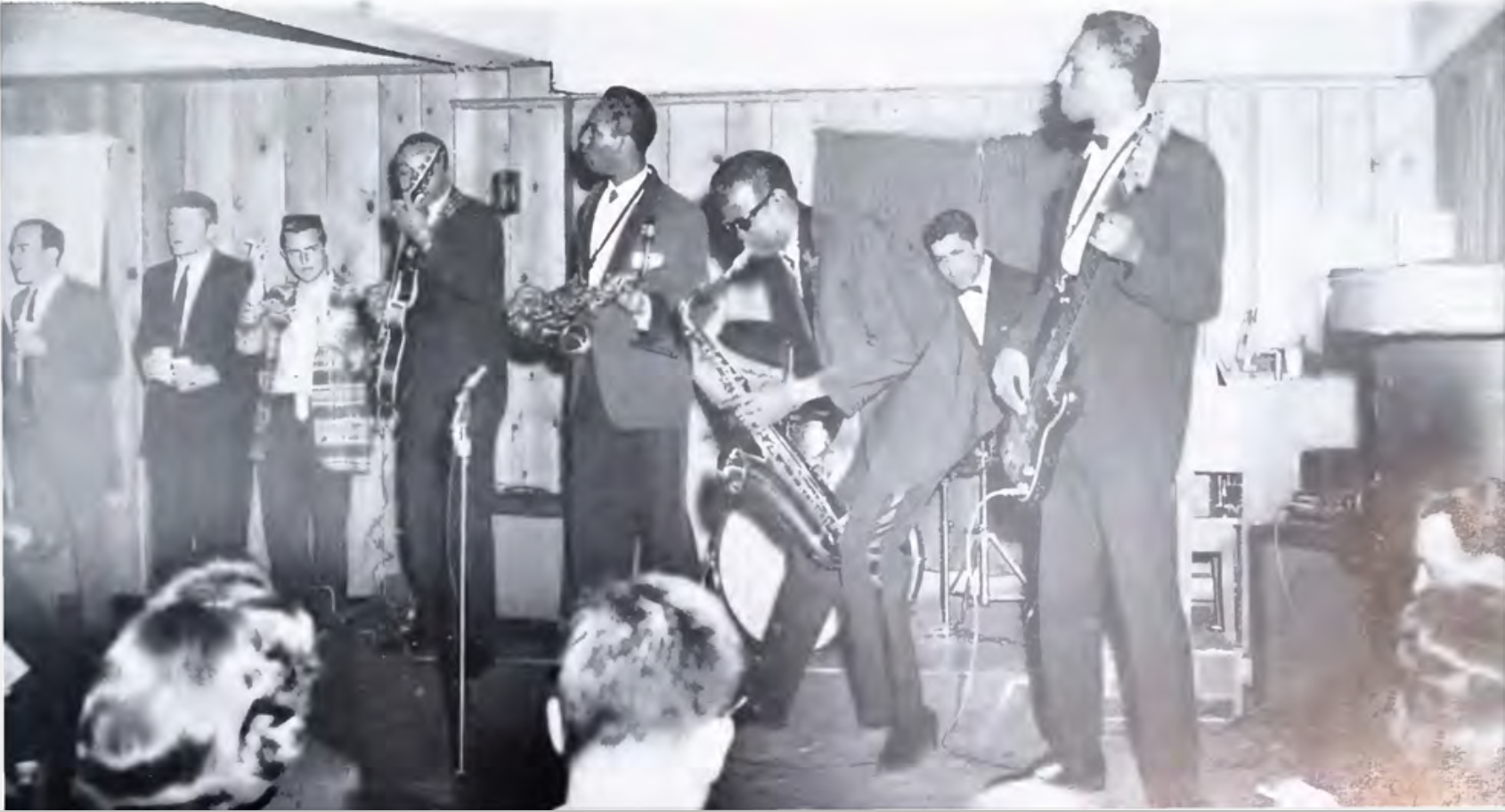
Images from Washington and Lee University

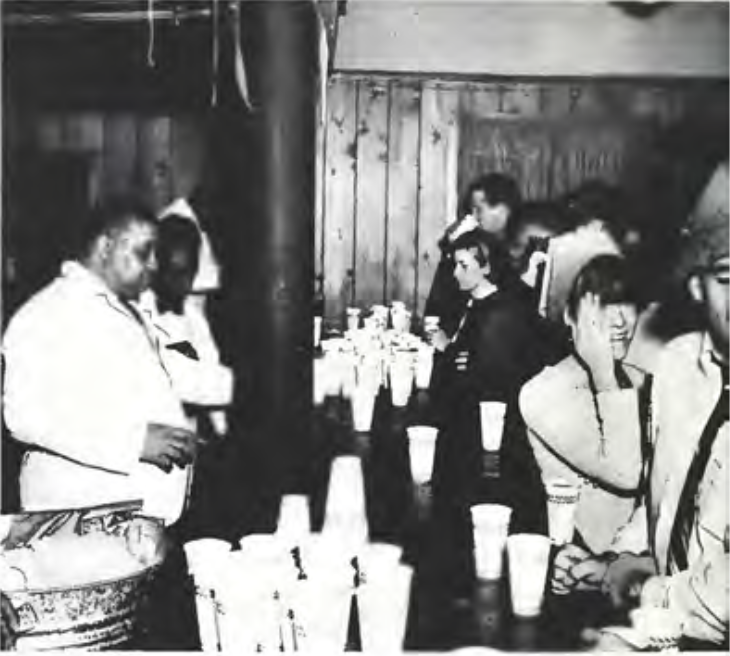
Sources
Sources from Carleton College:
***Carleton lacked both multicultural students and faculty during the majority of the 1960s. It was not until late 1967 that social issues like the Civil Rights Movement started to affect campus life.
Algol Yearbooks from the years 1960 to 1969
The Algol Yearbooks were a student-run yearbook first published in 1889, but it was not published annually until 1923, with the last yearbook issued in 2010. Access to the yearbooks is restricted to on-campus use and needs a Carleton username and password to access off-campus due to sensitivity regarding people’s privacy. However, we can still use the images and text in our project as it falls under the rights statement, but if needed, we can exclude and remove names and other sensitive information from our final project. Each yearbook has a transcript for each page, and images are downloadable.
- Issues: 1960, 1961, 1962, 1963, 1964, 1965, 1966, 1967, 1968, 1969
- Citation Example: Carleton College. (1960). Algol [Yearbook]. Carleton College Digital Collection. Retrieved from https://contentdm-carleton-edu.ezproxy.carleton.edu/digital/collection/Algol.
The Carletonian from the years 1967 to 1969
The Carletonian is Carleton’s weekly student-run newspaper and has been running since 1877. The Carletonian collection is open access, and therefore the texts are available for public use. Issues are available in PDF format, but they are not searchable and do not have an OCR text file.
- Issues: 9/28/1967, 10/19/1967, 10/26/1967, 11/02/1967, 11/9/1967, 11/16/1967, 11/23/1967, 1/25/1968, 4/1/1968, 4/4/1968, 4/11/1968, 4/18/1968, 4/25/1968, 9/19/1968, 10/17/1968, 10/24/1968, 10/31/1968, 11/14/1968, 4/10/1969, 5/15/1969, 6/10/1969
- Article Citations:
- ***The Carletonian covered nationwide protests and racial turmoil that started over the summer of 1967 in a section dedicated to civil rights reporting (on pg. 5-6) for several weeks beginning on October 19, 1967. On April 10, 1969, the Carletonian brought back the section with an article titled “Resistance Movements Consolidates”. The articles linked below only cover on-campus activism and changes.
- Williams, K. (1967, September 28). Openness Marks 1967 Project ABC. The Carletonian, pp. 1. Retrieved from http://edu.arcasearch.com/usmncar/.
- Williams, K. (1967, October 19). Negro Group Probes Campus Role. The Carletonian, pp. 1. Retrieved from http://edu.arcasearch.com/usmncar/.
- Luebke, T. (1967, October 26). Preacher, Barber Challenge Whites to Give Up ‘Racism’. The Carletonian, pp. 1. Retrieved from http://edu.arcasearch.com/usmncar/.
- Banks, N. (1967, November 2). Whites Respond to NAC Challenge. The Carletonian, pp. 1. Retrieved from http://edu.arcasearch.com/usmncar/.
- Banks, N. (1967, November 9). WAC Group Aims for Race Education. The Carletonian, pp. 1. Retrieved from http://edu.arcasearch.com/usmncar/.
- Michelson, M. (1967, November 16). Senate Condemns ‘Boredom’; Approves Convo Protest (CSA Sponsors NAC Convo). The Carletonian, pp. 1. Retrieved from http://edu.arcasearch.com/usmncar/.
- Luebke, T. (1967, November 23). Seek More Negro Students. Pall Hints at Student Spilt on NAC-WAC Intentions. The Carletonian, pp. 1. Retrieved from http://edu.arcasearch.com/usmncar/.
- Staff, (1967, November 23). (Students Poll on NAC) Pall Hints at Student Spilt on NAC-WAC Intentions. The Carletonian, pp. 6. Retrieved from http://edu.arcasearch.com/usmncar/.
- Staff, (1968, January 25). New Committee Probes Negro Role. The Carletonian, pp. 1. Retrieved from http://edu.arcasearch.com/usmncar/.
- Staff (1968, April 1). Carleton Guerilla Band To Fight Ethno-Racism. The Carletonian, pp. 1. Retrieved from http://edu.arcasearch.com/usmncar/.
- Wallace, N. (1968, April 4). New Board Urges More Negro Campus. The Carletonian, pp. 1. Retrieved from http://edu.arcasearch.com/usmncar/.
- Wallace, N. (1968, April 11). Mass Meeting Plans for Social Action. Carls Fast for The Way in Memory of Dr.King. College Seeks More Racially Mixed Staff. The Carletonian, pp. 1. Retrieved from http://edu.arcasearch.com/usmncar/.
- Shumacher, R. (1968, April 18). 700 Carls and Oles March; Show Concern for Racism. FAculty Comm. OKs Social Action Plans. The Carletonian, pp. 1. Retrieved from http://edu.arcasearch.com/usmncar/.
- Meldrum, M. (1968, April 18). Student Meeting Organizes Carleton Hometown Project. ‘Time’ Brings Natl’ Poll to Campus Wednesday. The Carletonian, pp. 1. Retrieved from http://edu.arcasearch.com/usmncar/.
- Summerville, J. (1968, April 25). Three Funds Drives Seek Support for Minorities. The Carletonian, pp. 1. Retrieved from http://edu.arcasearch.com/usmncar/.
- Staff, (1968, April 25). Action Starts in Twin Cities Core Project. The Carletonian, pp. 1. Retrieved from http://edu.arcasearch.com/usmncar/.
- Staff, (1968, September 19). Race Activists Set Community Center. The Carletonian, pp. 1. Retrieved from http://edu.arcasearch.com/usmncar/.
- Staff, (1968, October 17). Black Seek Work-Study Plan. The Carletonian, pp. 1. Retrieved from http://edu.arcasearch.com/usmncar/.
- Nelson, N. (1968, October 24). CONA Member Selection Poses Black Power Issue. The Carletonian, pp. 1. Retrieved from http://edu.arcasearch.com/usmncar/.
- Staff, (1968, October 31). Cornell Suspends Thirty Blacks. The Carletonian, pp. 1. Retrieved from http://edu.arcasearch.com/usmncar/.
- Staff, (1968, November 14). Ex-Candidate Gregory Makes Carleton Stop. The Carletonian, pp. 1. Retrieved from http://edu.arcasearch.com/usmncar/.
- Woolsey, J. (1968, November 14). Proxy Senate OKs Black Lounge. The Carletonian, pp. 1. Retrieved from http://edu.arcasearch.com/usmncar/.
- Dillenger, J. (1968, November 14). White Self-Education To Begin With Canvass. The Carletonian, pp. 1. Retrieved from http://edu.arcasearch.com/usmncar/.
- Honnold, E. (1969, April 10). Canvassers Encounter Local Racism. The Carletonian, pp. 1. Retrieved from http://edu.arcasearch.com/usmncar/.
- Newman, B. (1969, May 15). Hunger Strikes Called Off; SOUL Presses Demands. The Carletonian, pp. 1. Retrieved from http://edu.arcasearch.com/usmncar/.
- Neal, V. (1969, May 15). SOUL Questions College’s Black Admissions Policy. The Carletonian, pp. 1. Retrieved from http://edu.arcasearch.com/usmncar/.
- Neal, V. (1969, May 15). SOUL Questions College’s Black Admissions Policy. The Carletonian, pp. 1. Retrieved from http://edu.arcasearch.com/usmncar/.
- Staff, (1969, June 10). Apathy Stifles SOUL Class Boycott. The Carletonian, pp. 1. Retrieved from http://edu.arcasearch.com/usmncar/.
Sources from Washington and Lee University:
***The 1960s were a tumultuous time in the South and at W&L’s campus in particular due to Robert E. Lee’s significance to “Lost Cause” mythology. Significantly, W&L desegregated and allowed Black students to enroll in 1967. Any representations, or the lack thereof, of these students and the changes associated with the decade will be significant to our study.
The Calyx from the years 1960 to 1970
The Calyx is Washington and Lee University’s student yearbook that has been published annually since 1895. The catalog was digitized in its entirety from 2010 to 2011 and is currently maintained by the W&L University Library. Access is currently available in PDF format to faculty, students, and alumni and our use of the images within the archive is allowed under the rights statement.
- Issues: 1960, 1961, 1962, 1963, 1964, 1965, 1966, 1967, 1968, 1969, 1970.
The Ring-tum Phi from the years 1960 to 1970
The Ring-tum Phi is the completely student-run newspaper at Washington and Lee University that has been published since 1897. Although the paper has been published at varying intervals during its time in circulation, during the 1960s two different editions were published every week, a Tuesday and Friday edition. These two editions featured entirely different, sometimes collaborative, sometimes competitive contributoring and editing teams. Each edition is available in PDF format, and though they are not indexed, there is an OCRed Text that is searchable. The complete collection is part of W&L’s University Archives Record Group 39 and thus any images we use from this collection we have the following citation: Ring-tum Phi, edition date, (newspaper), Record Group 39: University Organizations and Societies, Special Collections and Archives, James G. Leyburn Library, Washington and Lee University, Lexington, VA
- Issues: Sept 1960 (Vol 61) – June 1970 (Vol 69)
